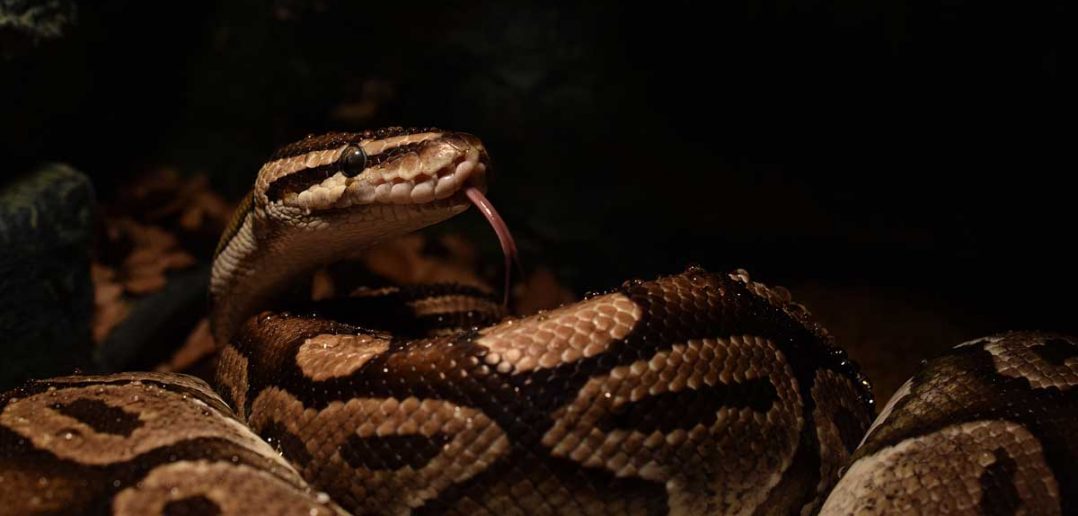Most people, even if they’re not pet lovers, smile if you mention fuzzy kittens and grimace if you mention pet snakes. Don’t believe me? Just mention the word snake tomorrow at the dinner table and I guarantee at least one person will cringe. In fact, I am that cringing person. I’m not a huge fan of snakes and will go out of my way to avoid them – and appreciate them going out of their away to avoid me as well.
I know there are a lot of snake fans out there, though, and I certainly appreciate the beauty of the creature as a pet, even if I have no desire to house one within my four walls. While movies, television shows and even books have portrayed snakes as sneaky and evil and out-to-get mankind at large, my snake-loving friends tell me that some snakes are actually more docile than a hamster.
Ball Pythons as Pets
If you’re considering a snake as a pet, a ball python (python regius or royal python) is a good choice if you are okay with knowing all pythons are constrictors, which means they wrap their bodies around prey and literally squeeze the life out of them. Remember Kaa from the Jungle Book? Rudyard Kipling’s character was an enormous python.
According to World Atlas, there are actually 11 surviving species of the genus Python which includes non-venomous reptiles, some powerful enough to kill humans. Ball pythons can grow to be an average of 3 to 5 feet long, they are one of the smallest, most popular pet pythons out there. It’s also important to note they can live 30 years or more and they are carnivorous (which means you’ll be buying mice to feed your friend).
When Ball Pythons started to be kept as pets they cost thousands of dollars but today there are breeders and a lot of pet stores sell them for around fifty dollars (depending on the “custom paint jobs” they are being bred for these days).
An increased popularity of ball python pets means a growing need for accurate information about keeping this type of snake as happy and healthy as possible!
Ball Python care sheets and videos can be found in many languages and on many sites throughout the web, allowing consumers the chance to get to know Ball Pythons before they actually go to the store or breeder to purchase their new pet. However, with the ease of duplicating information, the Ball Python has been fighting a losing battle for nearly 20 years.
The care sheets found on most sites and the information given to many consumers by pet store clerks is not correct, resulting in cold, dry and unhealthy Ball Pythons by the millions. Let’s discuss three of the major issues today that need to be corrected. All three issues related to the keeping of Ball Pythons are connected intimately to one another.
Keeping a Ball Python in a fish tank is the most common error suggested. This error is multiplied by retailers and manufacturers who care more about making money than the well being of the exotic Ball Python. Although fish tanks are readily available at almost any pet store across the world, they are not the correct enclosure for a Ball Python. Keeping this exotic snake requires more then space – it requires very specific heat and humidity requirements that are nearly impossible to obtain with a fish tank. It is imperative to the health and well being of Ball Pythons that they be housed in Ball Python Enclosures that have been specifically designed for Ball Pythons.
Ball Pythons were plucked from their homes in Northern Africa many years ago and have been breed in captivity ever since. Although these captive bred snakes have never felt the warm earth of ‘home’, they still require the same climate. Warmth is the second greatest mistake in Ball Python care. Along with the fishtank, most consumers will find that heat lamps are highly recommended by stores and care sheets. These popular reptile heat sources are terrific for providing both heat and light for many types of reptiles ranging from lizards to various species of snakes. Although they are the most popular source of heat, these lamps and domes create the wrong environment for a Ball Python. Ball Pythons do not naturally bask on logs or rocks like many other snakes, when heating their bodies. Ball Pythons do require heat, since they are cold blooded animals, but they require a different type of heat. Ball Pythons require an under tank heater (UTH). A UTH is available in the form of a tape, pad or cable and is very easy to install under the enclosure. Any UTH should be regulated using a thermostat to make sure it doesn’t exceed the recommended temperature and burn your Ball Python. In order for your Ball Python to behave in a stress free and natural way it must hide under branches or logs for the better part of the day, only coming out during the night.
While hiding, the Ball Python requires heat on its belly, which mimics the warm African earth. Although the heat on the floor of the enclosure is critical, it is also very important that the inside of the enclosure remain warm. If you were convinced either online or in a store to keep your Ball Python in a fishtank, you are likely doing one of two things. The first is that you are using a heat lamp, providing a wonderfully warm ambient temperature in the enclosure, leaving your Ball Python cold inside its hiding place forcing it to come out during the day when it should be hiding in order to get warm. The other possibility is that you have used the correct under tank heater, so your snake is comfortably warm during the day but cannot come out of the cave at night because the ambient air temperature is much too cold. The inherent issue with fish tanks is that the top of a fish tank is wide open allowing the warm air to escape into the room, leaving your Ball Python cold and stressed out about how to remain warm. Ball Pythons require temperatures in excess of ninety degrees Fahrenheit in order to digest food properly, among many other daily bodily functions. Keeping your Ball Python in a Ball Python enclosure will allow the air within the enclosure to remain warm, so your snake can behave appropriately without the need to worry about where and how it is going to heat up.
Finally, if you have ever walked through a hot jungle you would immediately notice that the air is humid and thick. Ball Pythons who live in fish tanks will be dry, and this is very unhealthy for a tropical snake such as a Ball Python. The air within the enclosure must be warm, but also it must be humid. In fact, the regular daily relative humidity within a Ball Python enclosure must not be lower than 50%. Ball Pythons require moisture just as much as heat and can fall very ill if the air is too dry.
The most common problem with Ball Python owners is skin stuck on the bodies and eyes of their Ball Pythons after a shed cycle. There is much debate on how to remove the skin that is stuck on a Ball Python after a poor shed. The solution lies not in the answer, but in the question. Why is the skin stuck on your Ball Python? 99% of the time the answer to this question is low humidity. Maintaining humidity between 50%-70% within a fish tank would require the addition of moisture several times a day, seven days a week. Since spraying down the substrate in the enclosure so many times a day is impractical, most owners allow their Ball Pythons to suffer in a dry and unforgiving environment. Moving a Ball Python from a dry fish tank to a Ball Python enclosure will be the greatest day for your Ball Python. We urge owners to think of the move as a lifetime investment for your snake’s health. Obtaining humidity at 50% within a Ball Python enclosure is as easy as spraying down the enclosure once every few days, less than 20% of the work required to maintain the same humidity as you would in a fishtank. You wouldn’t keep your reptile in a birdcage, so why would you keep it in a fishtank? ™
Ball Pythons are shy, docile and loving creatures. With so many Ball Pythons in North America it has become the responsibility of owners to make sure that these silent creatures get the care they deserve. Although snakes are not able to tell you that they are suffering, they do suffer in huge numbers do to improper care. Ball Pythons are easy to maintain and care for, as long as you remember the three cardinal rules, use the correct enclosure, heat source and maintain the proper humidity.
Once you have created the correct environment for your snake it will shed its skin, eat its food and behave in a much more natural way. In fact, a less stressed out Ball Python will also become a much more docile and friendly snake. So please, ignore the incorrect information you find on the web, and make sure to be the voice for your snake. Ask the right questions, and search for the correct answers.
Thank you to Ricky’s Reptile Enclosures for the ball python information he’s shared. Ricky has been a pet owner all his life, with a special interest in Ball Pythons over the past 11 years. He has been working as a designer and engineer of casegoods for the past 7 years and started Ricky’s Reptile Enclosures this past year. Ricky’s first priority is to educate the public about the correct care for Ball Pythons and to help the millions of Ball Pythons who suffer daily throughout the world.





10 Comments
I really enjoyed this post!
I have actually been looking into getting a Ball Python for a while now but haven’t found any reliable information. I’m going to use this to propel me into buying a new snake.
It’s such a breath of fresh air to find someone who is being honest rather than just regurgitating other peoples information.
Thanks for taking the time to write this Ricky!!
Really informative! It’s great to see this information being shared widely. Anyone who chooses ball pythons as their companion animals should take note of this!
Wow, I had no idea I have been housing my ball pythons in the wrong enclosure! This was a super helpful article, and finally provides the correct information about how to properly care for BP’s….definitely going to check out your site, thanks Ricky!
I never knew how interesting ball pythons were! VERY good article. I also have a pet site, but it focuses on pet travel tips. https://www.petxcursion.com
Do you suppose snakes would enjoy a vacation with their owners too? 🙂
I never realized there was so much to keeping a ball python. Very informative.
This article has some great advice. Poor husbandry is one of the most common reasons that reptiles get sick.
One thing that is not mentioned in this article is UV light. All reptiles require access to unfiltered (ie not through glass) UV light.
This is best accomplished by 20-30 minutes out in the sun 2-3 times per week. In-cage UV lamps are OK, but need to be replaced frequently.
I just wish people would understand when wanting to get ball pythons as pets – it goes beyond having a “cool” pet! Which is one of the main reasons people get them. They are dangerous & have the potential to kill as any pet can.
I have no qualms about people owning exotic pets such as snakes. I just wish there were more educated & responsible owners out there!
This article is a great start to getting down the right path as a snake owner!! Knowledge is power. And a well & properly cared for pet is a happy one!
Shannon Cole – Shannon’s Pet-Sitting
Compassionate , Professional, Better Business Bureau Accredited Pet Care.
Serving Suburban Lake, Cook, & Kane Counties in Illinois.
WEBSITE: http://www.shannonspetsitting.net
BLOG: http://shannonspet-sittingtwilightbark.blogspot.com/
EMAIL shannonspetsitting@hotmail.com
Your information was very accurate! Everything does make sense. However I don’t think that “fish tanks” are bad for the snakes. If you have the proper temps. and humidity then your good. I think you are attacking the “fish tanks” because you want people to buy your product, but otherwise great information.
Very comprehensive post you covered a lot of basic husbandry questions.
Pingback: Canadian Reptile Breeders Expo « Healthy Pets « Healthy Pets Now